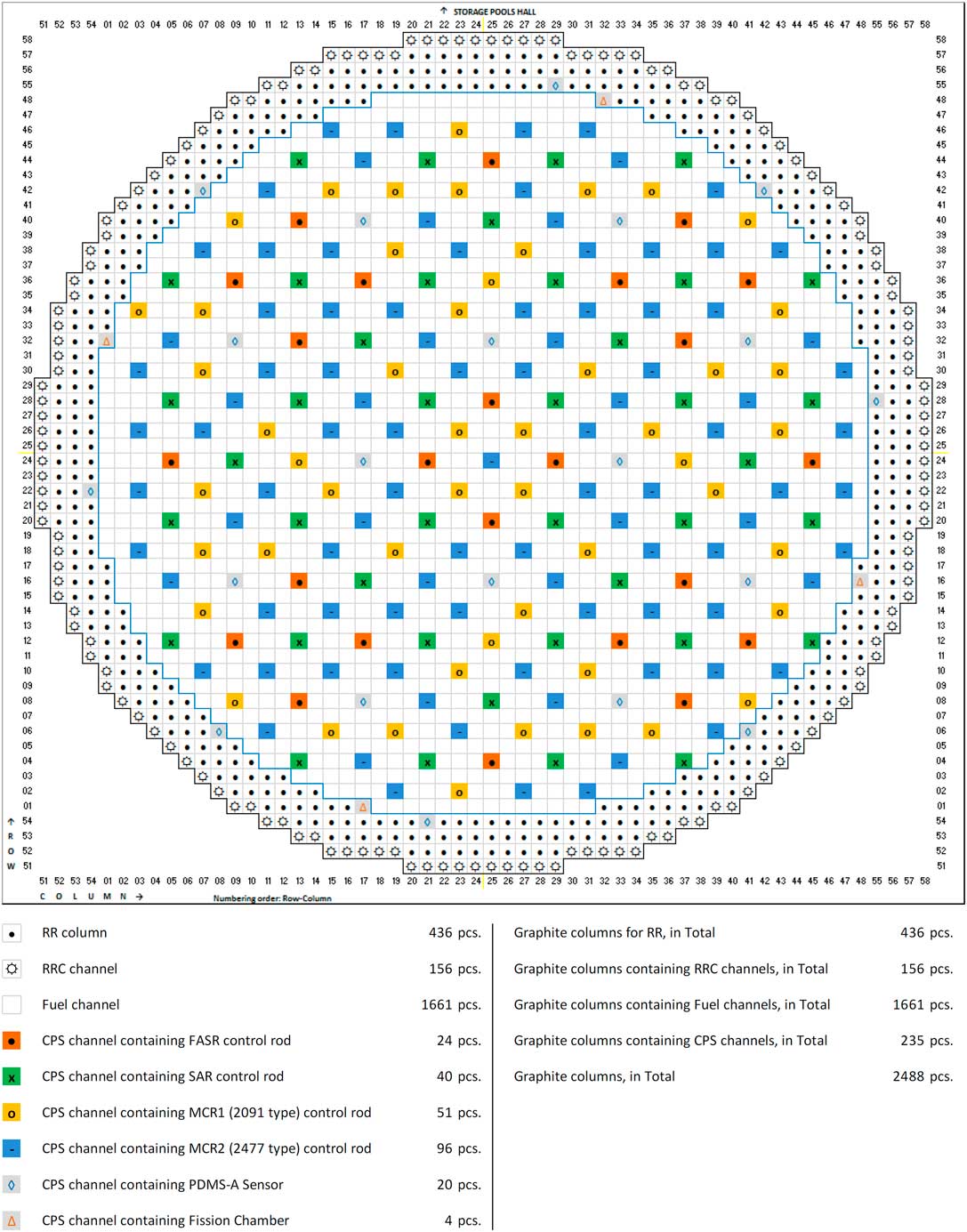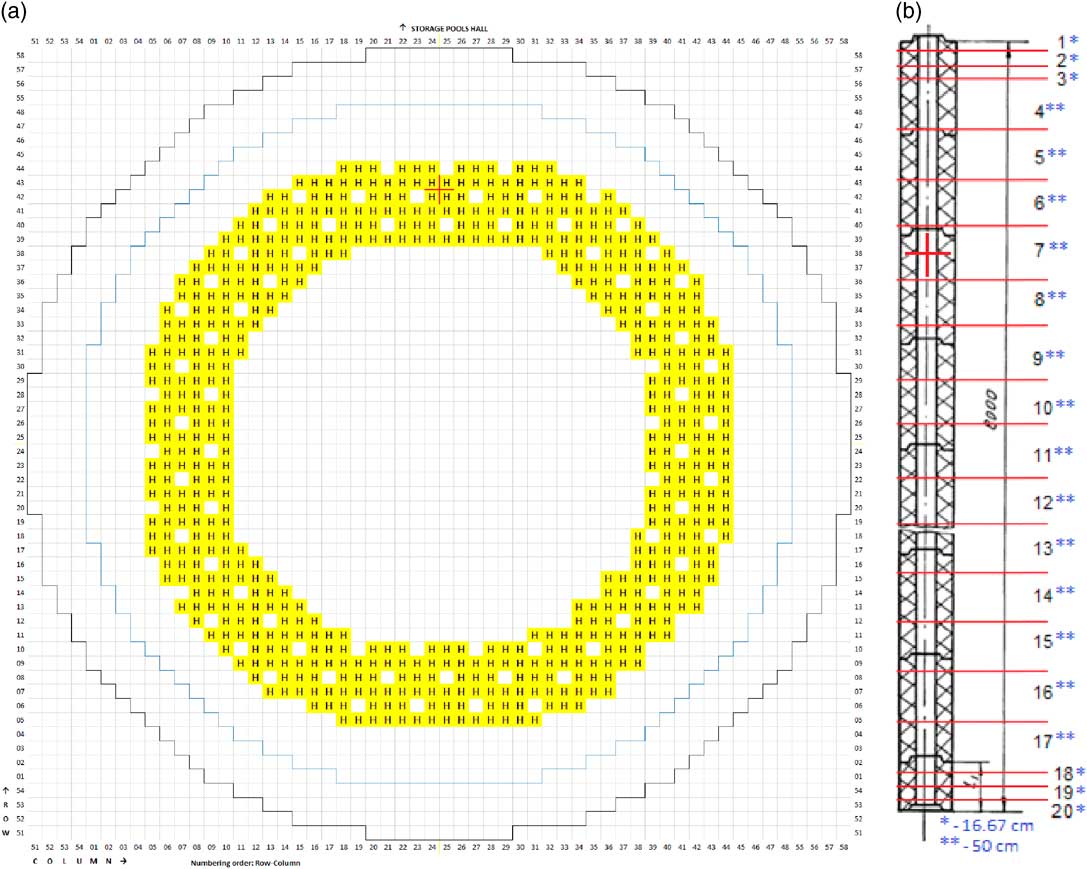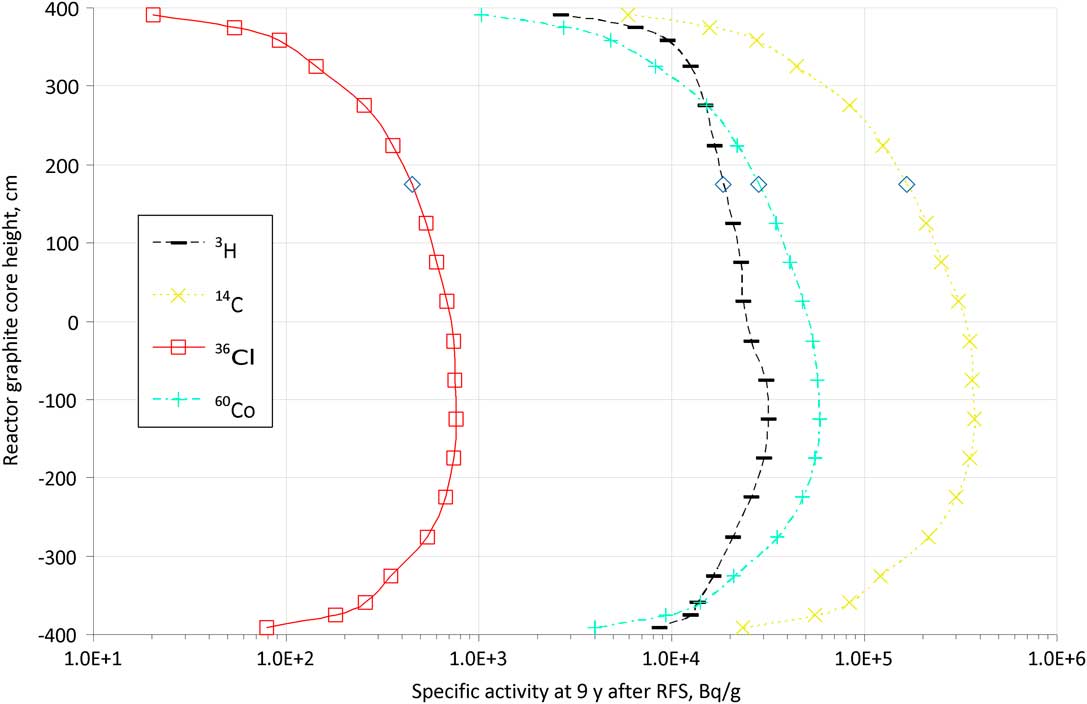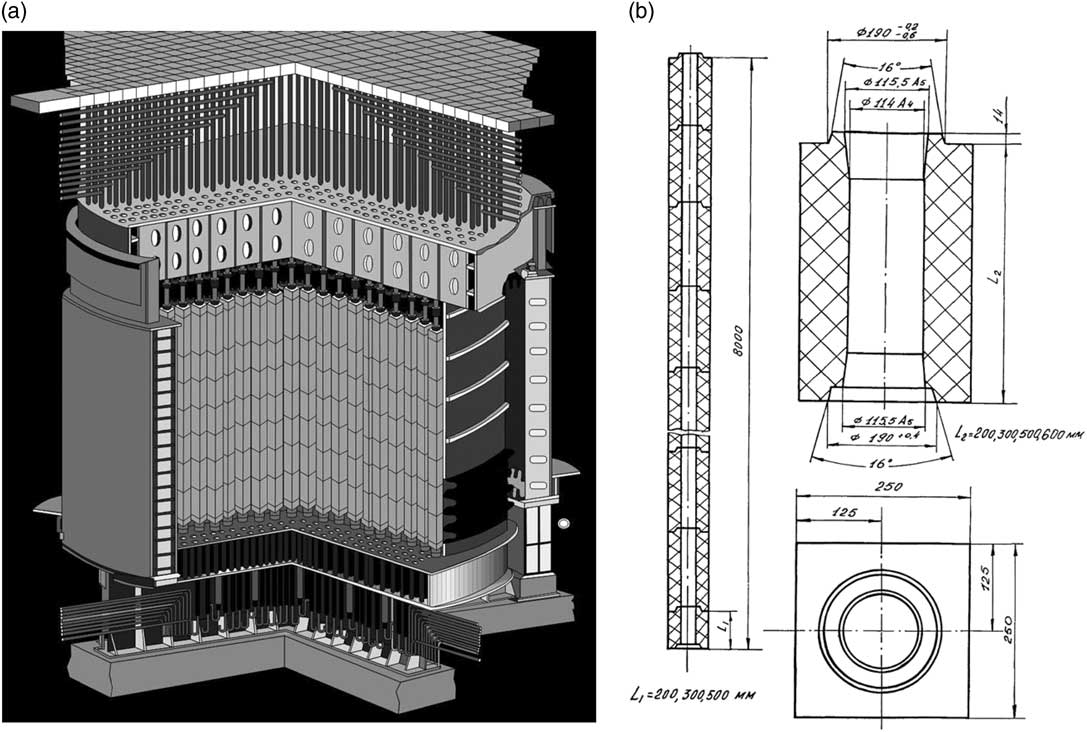INTRODUCTION
The Ignalina NPP is located in the northeast part of Lithuania and contains two power units with an RBMK-1500 reactor in each unit. While in operation, these reactors were the most powerful and most advanced versions of all RBMK reactors. Since the end of 2004, Unit 1 has been permanently shut down (its start-up dates to the end of 1983). After shutdown, a number of Unit 1 systems and equipment were radiologically characterized and dismantled. However, this work was performed for relatively low contamination systems, while the reactor itself is intact (although defueled) and not radiologically characterized. The highest volume of reactor structures is attributed to the stack of the reactor core, which is constructed from graphite blocks; the radiological characterization of this is of great importance. Earlier studies (Ancius et al. Reference Ancius, Ridikas, Remeikis, Plukis, Plukiene and Cometto2005; Smaizys et al. Reference Smaizys, Narkunas and Poskas2005; Narkunas et al. Reference Narkunas, Smaizys, Poskas and Kilda2010) revealed that the radiological inventory in irradiated RBMK-1500 reactor graphite could be dominated by the radionuclide 14C, however estimations were based on conservative assumptions and lacked experimental activity measurement data. The production of 14C in nuclear reactors is typically dominated by neutron activation of 14N and 17O (Svetlik et al. Reference Svetlik, Fejgl, Povinec, Korinkova, Tomaskova, Pospichal, Kurfirt, Striegler and Kaufmanova2017), but for graphite moderated reactors, the influence of 13C could also be significant (Narkunas et al. Reference Narkunas, Smaizys, Poskas and Kilda2010). The importance of 14C in the radioactive waste of Ignalina NPP was also presented in (Vaitkeviciene et al. Reference Vaitkeviciene, Mazeika, Skuratovic, Motiejunas, Vaidotas, Orysaka and Ovcinikov2013). Therefore, within the EC 7th FP project CAST, one of the tasks was to estimate 14C inventory based on a combination of available activity measurements and full 3D reactor graphite stack neutron activation modeling. Results in relation to 14C, as well as 3H, 36Cl, and 60Co inventory estimations, are presented in this paper.
RBMK-1500 REACTOR DESCRIPTION
A general view of the RBMK reactor is presented in Figure 1. The RBMK-1500 is a graphite-moderated, water-cooled, channel-type boiling water reactor having a thermal power generation capacity of 4800 MW, which was decreased to 4200 MW after the Chernobyl accident. The reactor is housed in a 25 m deep, 21×21 m wide concrete vault. The core volume is dominated by a large cylindrical graphite stack. The graphite stack is located in a hermetically sealed cavity, consisting of a cylindrical wall and top and bottom metal plates, which is filled with a helium-nitrogen mixture (nitrogen content ~60% by mass) that prevents graphite oxidation and improves heat transfer from the graphite to the fuel channels. This helium-nitrogen mixture also precludes the radiolytic corrosion of graphite in RBMK reactors.
The stack can be visualized as a vertical cylinder 8 m high and 14 m diameter, made up of 2488 graphite columns arranged next to each other without keying. The outer four rows of columns of the stack make up the radial reflector (RR), and a 0.5 m thick layer at the top and bottom make up the top and the bottom reflectors, respectively. The total mass of graphite blocks in a whole graphite stack is about 1700 tonnes.
Every graphite column is constructed from graphite blocks of different height, see Figure 1. The blocks are rectangular parallelepipeds, with a base of 0.25×0.25 m, and heights of 0.2, 0.3, 0.5, and 0.6 m, of which the 0.6 m blocks are most common.
The layout of the graphite columns in the RBMK-1500 reactor at Ignalina NPP Unit 1 is shown in Figure 2, while a detailed description is given below.

Figure 2 Layout of graphite columns in RBMK-1500 reactor at Ignalina NPP Unit 1.
The blocks have a 0.114 m diameter bore opening through the vertical axis. This provides a space for a total of 2052 channels, which are used for placing fuel assemblies (FA) (so-called fuel channels – FC), reactor regulating control rods and several types of other instrumentation (so-called control and protection system channels – CPS channels) into the core and cooling of radial reflector (so-called radial reflector cooling channels – RRC channels). The blocks of the remaining 436 columns located within the radial reflector have the central bore openings of 0.089 m diameter and this space is filled by graphite rods providing keying of the blocks within the column, increasing the density and neutron reflecting effectiveness of this part of the graphite stack. Graphite rods are manufactured from a different grade graphite compared to the blocks (GRP-1-280 is the grade of graphite used for rods while GR-280 is the grade used for blocks), however the total mass of the graphite rods in a whole graphite stack is much lower, i.e. ~60 tonnes.
Within the reactor core, FC and CPS channels are positioned by the help of special graphite rings and sleeves. The central segment of FC is surrounded by the 0.02 m high and 0.0115 m thick split rings, of GRP-2-125 grade graphite. These rings are arranged next to one another in such a manner that one is in contact with the channel, and the other with the graphite stack block. Above and below the graphite rings section, GRP-2-125 grade graphite sleeves of different shape and size are also placed. The arrangement of graphite rings and sleeves for CPS channels is somewhat different. The total mass of the graphite rings and sleeves of FC and CPS channels is ~120 tonnes in the reactor.
CPS channels could be equipped with control rods of 4 different types. Manual control rods of type 1 (MCR1) were control rods of an initial design, used to control the radial field of energy distribution. Subsequently, part of the MCR1 rods were replaced by the modified control rods (MCR2). Fast acting scram rods (FASR) were used to rapidly cease the nuclear chain reaction. Shortened absorber rods (SAR) were used to control the axial field of energy distribution. Additionally, some of CPS channels were equipped with the axial power density monitoring system sensors (PDMS-A) and fission chambers for monitoring purposes.
METHODOLOGY
The general methodology used for the radionuclide inventory estimation consists of three main parts. The first part is to obtain the activity distribution of radionuclides within the graphite stack of RBMK-1500 reactor based on spatial neutron flux modeling and corresponding neutron activation modeling, assuming a maximal initial impurities content (as a conservative case) in graphite. Next, knowing the experimental values of measured radionuclide activities in specific places (points) of the graphite stack, the causative concentrations of relevant impurities in graphite are derived by reverse activation modeling at those specific measurement places. This is achieved by altering the concentration of an impurity, whose activation leads to the generation of a particular radionuclide, until the modeled activity of that radionuclide matches the measured one. Finally, by employing the derived causative concentrations of relevant impurities, neutron activation modeling is performed and inventories of analyzed radionuclides in the whole graphite stack are obtained.
The spatial and energy distribution modeling of the neutron flux was performed using MCNP 5 ver. 1.6 code (X-5 MONTE CARLO TEAM 2003), employing ENDF/B-VII nuclear data library (in the main). The developed 3D model envelopes the whole RBMK-1500 reactor core with the graphite stack consisting of 2488 graphite columns and surrounding structures, in the space region of 21×21×15 m (21×21 m is the length and the width of a concrete reactor vault while 15 m is the height of the modeled reactor core including surrounding structures).
Numerous data relating to the RBMK-1500 reactor were used while developing the MCNP 5 model. These data were: geometry (dimensions) of the reactor core internals and surroundings, compositions and densities of the materials, reactor operation parameters and others. The parameters of all reactor components defined in the model (temperatures, densities, dimensions, etc.) were set to match the conditions of the reactor working at the nominal 4200 MW thermal power generation capacity. All the data were based on the information presented in technical documentation (e.g. Ignalina Nuclear Power Plant 1985; Almenas et al. Reference Almenas, Kaliatka and Uspuras1998). The Ignalina NPP Unit 1 reactor RBMK-1500 model was developed assuming that:
∙ Every control rod in the CPS channel (of 211 CPS channels with control rods in total) is in its full withdrawn position;
∙ Every FC (of 1661 FC in total) is loaded with FA containing UO2 fuel of average burnup of ~10 MWd/kgU, with initial 2.4% 235U enrichment and 0.41% burnable Er2O3 absorber content.
This model developed for the RBMK-1500 reactor was used for modeling of the neutron flux in all graphite columns of the stack. However, this approach is still conservative, as all the control rods in the CPS channels are modeled in their full withdrawn positions, i.e. neutron flux in the active core is not affected by the presence of the absorbing part of the CPS control rod, which is located just above (for SAR rods just below) the active core, and is even favored by the presence of the control rod graphite displacers in the active core.
In order to evaluate the differences in neutron flux in the graphite columns containing different equipment and located in a different reactor part, the neutron flux was evaluated separately for 11 groups of the graphite columns (see Figures 2 and 3):
∙ With fuel channel (580 pieces) in the central part of the active core;
∙ With fuel channel (601 pieces) in the 1st peripheral part of the active core;
∙ With fuel channel (480 pieces) in the 2nd peripheral part of the active core;
∙ RR column (436 pieces) containing graphite rods;
∙ With RRC channel (156 pieces);
∙ With CPS channel containing MCR1 control rod (51 pieces);
∙ With CPS channel containing MCR2 control rod (96 pieces);
∙ With CPS channel containing SAR control rod (40 pieces);
∙ With CPS channel containing FASR control rod (24 pieces);
∙ With CPS channel containing PDMS-A sensor (20 pieces);
∙ With CPS channel containing fission chamber (4 pieces).

Figure 3 Layout of graphite columns (a) [including axial segmentation (b)] containing fuel channels in RBMK-1500 reactor first peripheral part at Ignalina NPP Unit 1.
The neutron flux obtained in every group of graphite columns was averaged over the whole cross-section of columns in the lateral direction and over the heights of 20 segments in the axial direction. The heights of 14 segments in the active core were 50 cm each, while the heights of the remaining 6 segments (3 in the top and 3 in the bottom reflector region) were 16.67 cm, see Figure 3. In this way, the spatial neutron flux distribution in the whole graphite stack was obtained (11 groups of graphite columns divided into 20 segments in axial direction). These flux distributions were then used for the neutron activation modeling, i.e. evaluation of the spatial distribution of the induced specific activity of 14C, 3H, 36Cl, and 60Co in the graphite stack of the Ignalina NPP Unit 1 reactor.
Neutron activation modeling was performed using SCALE 6.1 codes system (SCALE ORNL/TM-2005/39 2011). The ORIGEN-S computer code from the SCALE 6.1 codes system was used for the neutron activation modeling. The COUPLE code (also from SCALE 6.1 codes system) was used to collapse the multigroup cross-sections using the spectrum (in a 238 energy group structure) obtained from the MCNP modeling and to prepare the resulting weighted cross-sections to produce a binary ORIGEN-S library that is specific for the current problem. Having problem-specific cross-section data and using total neutron flux, the neutron activation modeling of the reactor RBMK-1500 graphite stack (GR-280 grade graphite blocks) was performed. The Ignalina NPP Unit 1 reactor RBMK-1500 operation history was also used in the modeling, i.e. it was assumed that for the first 17 years, the reactor operated at different annual regimes but continuously without shutdowns, and that during each year the operation regime remains constant. The remaining 4 years of operation were divided into 25 shorter periods, taking into account all reactor shutdowns for more detailed representation. As was already mentioned, conservatively, maximal initial impurities content in GR-280 graphite grade (Narkunas et al. Reference Narkunas, Smaizys, Poskas, Druteikiene, Duskesas, Garbaras, Gudelis, Gvozdaite, Lujaniene, Plukiene, Plukis and Puzas2013) was used at this stage.
Later, having experimental values of measured radionuclides activities in specific places of the graphite stack, the causative concentrations of relevant impurities in graphite were obtained by reverse activation modeling at those measurements places, i.e. neutron activation modeling was performed only for those specific places of the graphite stack according to the above-presented methodology, except the change of initial content of impurities leading to generation of the radionuclides 14C, 3H, 36Cl, and 60Co. The concentrations of these impurities were altered until the modeled activities of analyzed radionuclides matched the measured ones, i.e. in this way the causative concentrations were determined.
Finally, employing causative concentrations of relevant impurities, neutron activation modeling was performed for the whole graphite stack and inventories of analyzed radionuclides were obtained.
RESULTS AND DISCUSSION
Neutron flux modeling results as well as activation modeling results using maximal impurities concentrations are not presented here in detail, as they are intermediate results. Rather, the main emphasis is afforded to the final result—the estimation of radionuclide inventories in irradiated RBMK-1500 graphite, based on a combination of experimental measurements and numerical modeling.
Sampling of the Ignalina NPP Unit 1 RBMK-1500 reactor graphite stack had been already done by the Ignalina NPP staff and it was expected that radiological characterization of the samples taken will be made during the course of the CAST project. However, over this time period no results of GR-280 grade graphite radiological characterization were made publicly available, except in a paper by Mazeika et al. (Reference Mazeika, Lujaniene, Petrosius, Orysaka and Ovcinikov2015). This paper presented preliminary studies of the experimental 14C, 3H, 36Cl, and 60Co activity measurements in several graphite sub-samples, attributed to the same sample of the GR-280 grade graphite bushing from the temperature channel of the Ignalina NPP Unit 1 RBMK-1500 reactor. According to the information on the location of the analyzed sample (Mazeika et al. Reference Mazeika, Lujaniene, Petrosius, Orysaka and Ovcinikov2015), the sample was taken from the area of first peripheral part of the graphite columns with fuel channels in the RBMK-1500 reactor, at +175 cm elevation (see Figure 3 where sample places are indicated with cross marks). Based on the statistical analysis of the sub-sample’s activity, the average activity values of the analyzed radionuclides, including relative standard deviation (RSD), were (Mazeika et al. Reference Mazeika, Lujaniene, Petrosius, Orysaka and Ovcinikov2015):
∙ 14C specific activity: 1.67×105 Bq/g ± 36.7% (RSD);
∙ 3H specific activity: 1.85×104 Bq/g ± 1.2% (RSD);
∙ 36Cl specific activity: 4.50×102 Bq/g (rough data);
∙ 60Co specific activity: 2.85×104 Bq/g ± 17.7% (RSD).
As the measurements of the taken sample were performed ~9 years after Unit 1 reactor final shutdown (RFS), results of induced activity modeling were also obtained for the same date. The activities of 14C, 3H, and 36Cl were measured by the liquid scintillation counting technique, after appropriate sample digestion by acids, whereas activity of 60Co was measured by direct gamma spectroscopy (Mazeika et al. Reference Mazeika, Lujaniene, Petrosius, Orysaka and Ovcinikov2015).
Comparing measurement results with the ones obtained by the numerical modeling using maximal initial impurities concentrations, it was found that modeling results for the first peripheral part of the graphite columns with fuel channels in the RBMK-1500 reactor, at +175 cm elevation (i.e. those that correspond to the place of measured sample) are considerably higher than the measured ones. This was a clear indication that the maximal concentrations of impurities leading to the induction of 14C, 3H, 36Cl, and 60Co are too high and that the use of these maximal concentrations results in an overestimation of the real radionuclide inventory. The main impurities leading to the induction of 14C, 3H, 36Cl, and 60Co are N (nitrogen), Li (lithium), Cl (chlorine), and Co (cobalt), respectively. Therefore, concentrations of these impurities were decreased until the modeled activities of the analyzed radionuclides matched the measured ones, and in this way the so-called causative concentrations were determined. Impurity concentration data used and obtained in this study are presented in Table 1.
Table 1 Concentrations of impurities in GR-280 grade graphite.

From Table 1, it can be seen that the determined causative concentrations of all impurities fall in the range of reported concentrations except Li, for which the causative concentration was determined as ~2 times lower than the reported minimal concentration. This in general indicates that the derived causative concentrations and whole modeling approach could be treated as reasonable. Furthermore, the modeled production of 3H from raw graphite material (i.e. nuclide 12C) constituted ~12 % (2.24×103 Bq/g) of the total 3H specific activity in the measurement place, whereas the production of 14C from raw graphite material (i.e. nuclide 13C including production from 12C through 13C) – ~18% (3.02×104 Bq/g) of total 14C.
Subsequently, by employing the derived causative concentrations of relevant impurities, neutron activation modeling was performed for the whole graphite stack, i.e. 11 groups of graphite columns divided each in 20 segments in the axial direction. Axial distributions of the modeled 14C, 3H, 36Cl, and 60Co specific activities for the graphite columns with fuel channels in the RBMK-1500 reactor first peripheral part are presented in Figure 4. The measured specific activities of 14C, 3H, 36Cl, and 60Co from (Mazeika et al. Reference Mazeika, Lujaniene, Petrosius, Orysaka and Ovcinikov2015) are also indicated as rhombs in Figure 4. Analogous axial distributions of the modeled specific activities of analyzed radionuclides were obtained for the remaining 10 groups of graphite columns as well, although these are not graphically presented here.

Figure 4 Axial distribution of the modeled 14C, 3H, 36Cl, and 60Co specific activity in the graphite columns containing fuel channels in RBMK-1500 reactor first peripheral part at Ignalina NPP Unit 1 at 9 years after the time of RFS (measured specific activities are indicated as rhombs).
From Figure 4 it can be seen that the axial profiles of 14C, 36Cl, and 60Co are quite similar and more or less follow the axial distribution profile of thermal neutron flux (although neutron flux modeling results are not presented here), indicating that activation by thermal neutrons is dominant. For 3H, the situation is somewhat different, as the distribution profile differs, indicating the influence of faster neutrons.
By having the modeled distributions of the specific activities of 14C, 3H, 36Cl, and 60Co in each group and segment of the graphite columns, and by applying quantities and masses of the graphite columns segments in the respective group, the integral 14C, 3H, 36Cl, and 60Co activities in the whole graphite stack were calculated. Results of these estimated activity inventories of analyzed radionuclides are presented in Table 2. Results show that, based on the combination of radionuclide activity modeling and measurement techniques, the total inventory of 14C is estimated as 3.22×1014 Bq in the irradiated graphite stack of the Ignalina NPP Unit 1 RBMK-1500 reactor at 9 years after the time of RFS. 14C activity is the highest among the analyzed radionuclides and the second highest is 60Co, with an activity ~6 times lower. The activity of 3H is one order of magnitude lower and the activity of 36Cl is more than two orders of magnitude lower, compared to the 14C activity. Average specific activities of radionuclides presented in Table 2 were obtained by dividing the total inventory in the reactor graphite stack by the mass of the graphite stack.
Table 2 Radionuclide activities in the graphite stack of the Ignalina NPP Unit 1 RBMK-1500 reactor at 9 years after the time of RFS.

a Relative standard deviation (RSD) of the estimated total and average specific activity is no less than the RSD of measured specific activity.
b Average activity is obtained dividing total activity in the graphite stack by the mass of the stack (1.7×109 g).
However, it should be noted that the above estimated total and specific activities are only for the reactor RBMK-1500 graphite stack consisting of GR-280 grade graphite blocks. The remaining graphite components in the reactor (200 t in total, i.e. ~12% of the GR-280 grade graphite blocks mass; graphite rings, sleeves, rods and other graphite parts in minor quantities) are not taken into account. These parts were manufactured from a different graphite grade and operated at different conditions, therefore the above-presented results cannot be directly applied to them and need additional investigations or justification.
Results obtained by only numerical estimation in one of the earlier studies (Ancius et al. Reference Ancius, Ridikas, Remeikis, Plukis, Plukiene and Cometto2005) showed that specific activity of 14C is ~5×105 Bq/g, 3H is ~9×104 Bq/g, 36Cl is ~4×103 Bq/g and 60Co is ~4×104 Bq/g in the graphite stack (moderator) at 9 years after the time of RFS. Comparing these results with the ones obtained in this study and presented in Table 2, it is clear that a combination of modeling and measurement techniques gave results from ~1.3 (for 60Co) up to ~10 (for 36Cl) times lower, i.e. conservatism of nuclides inventory was decreased.
Additional caution should be paid to the above-presented estimation of the total and the average specific activities of 14C, 3H, 36Cl, and 60Co in Ignalina NPP Unit 1 reactor RBMK-1500 graphite, as the estimation performed relies only on the preliminary measurements of one graphite sample. It could not be totally excluded that the measurements of the sample are somehow misleading, and the sample is not representative. Nevertheless, these are the only officially published measurement results of 14C activity in the GR-280 grade graphite of Ignalina NPP Unit 1 reactor to date, and they were used in the presented study.
CONCLUSIONS
As a main emphasis of this study, it can be concluded that, by combining 14C, 3H, 36Cl, and 60Co measurement and activity modeling results, the following activity inventories in the irradiated graphite stack of the Ignalina NPP Unit 1 RBMK-1500 reactor at 9 years after the time of reactor final shutdown were obtained:
∙ Total 14C activity in the graphite stack: 3.22×1014 Bq;
∙ Total 3H activity in the graphite stack: 3.22×1013 Bq;
∙ Total 36Cl activity in the graphite stack: 6.94×1011 Bq;
∙ Total 60Co activity in the graphite stack: 5.19×1013 Bq.
However, it should be also noted that the numbers above are only for the reactor RBMK-1500 graphite stack consisting of GR-280 grade graphite blocks. The remaining graphite components in the reactor (graphite rings, sleeves, rods and other graphite parts in minor quantities) are not accounted for in this summary. Furthermore, the estimation presented relies on the preliminary measurements of only one graphite sample.
ACKNOWLEDGMENTS
This work has partly been funded by the EC Project CAST (FP7-604779) and Lithuanian Agency for Science, Innovation and Technology (31V-3/14-1707.17.17).









